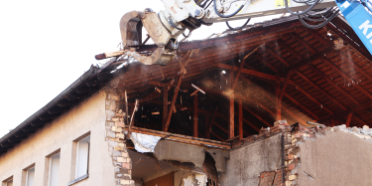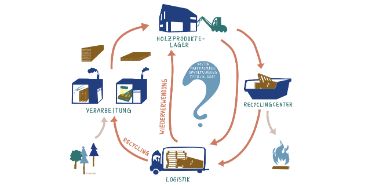Think Earth: Recycling and Reuse of Timber
Development and implementation of a value chain for waste wood in Switzerland, with a focus on industrial solid wood products (Innosuisse Flagship Think Earth, subproject 5, BFH part)
Factsheet
- Schools involved School of Architecture, Wood and Civil Engineering
- Institute(s) Institute for Building Materials and Biobased Products IBBM
- Research unit(s) Materials and Life Cycle Assessment group FGWO
- Funding organisation Innosuisse
- Duration (planned) 01.02.2024 - 01.02.2027
- Head of project Patrick Fuchs
-
Partner
ETH Zürich, Institut f. Baustoffe (IfB)
Swiss Krono AG
OLWO AG
Schneider Umweltservice AG
AHB Stadt Zürich
Brawand Zimmerei AG
PIRMIN JUNG Schweiz AG - Keywords Circular economy, cascading use, waste wood
Situation
In Switzerland, the recycling rate for wood is around 20%, significantly lower than for other building materials such as steel or concrete. A large proportion of this recycled waste wood is shredded and used to produce chipboard. The remaining 80% or so is mainly incinerated and thermally recycled. The aim of this project is to significantly increase the proportion of material recovery from waste wood, whether through recycling or reuse. The project is being carried out in close collaboration with the Institute for Building Materials (Prof. Ingo Burgert) at ETH Zurich and the implementation partners. At BFH, the main focus is particularly on developing industrially producible solid wood products from waste wood that offer a higher level of material cascading than chipboard. The urgency also arises from the predicted shortage and change in the range of raw materials due to the impact of climate change on domestic forests, and the simultaneous growth in market demand for the raw material wood. A key objective is to establish an efficient structure for the reuse and recycling of waste wood in Switzerland. Key challenges are the dismantling, the logistics and the processing, the removal of pollutants and fasteners, and the regulatory framework conditions.
Course of action
The main concerns of the project are systematically addressed in several work packages. The starting point is a literature-based analysis of waste wood flows in Switzerland, which provides a sound basis for further project steps. Building on this, a detailed investigation into waste wood sources will be conducted with regard to availability, quality and the technical and logistical effort required for recovery. As part of this analysis, selected deconstruction projects in building construction will be monitored and evaluated as case studies to gain practical insights into the processes and challenges of waste wood recovery. The aim is to build on this in order to develop and test new concepts for the extraction, transportation and sorting of waste wood. Another central focus is on product and technology development. The detection and removal of harmful substances, such as wood preservatives and metal parts, is an essential prerequisite for high-quality recycling. The entire development process is accompanied by analyses of costs and environmental impacts to include both economic and ecological aspects in the evaluation and optimisation of the processes.


